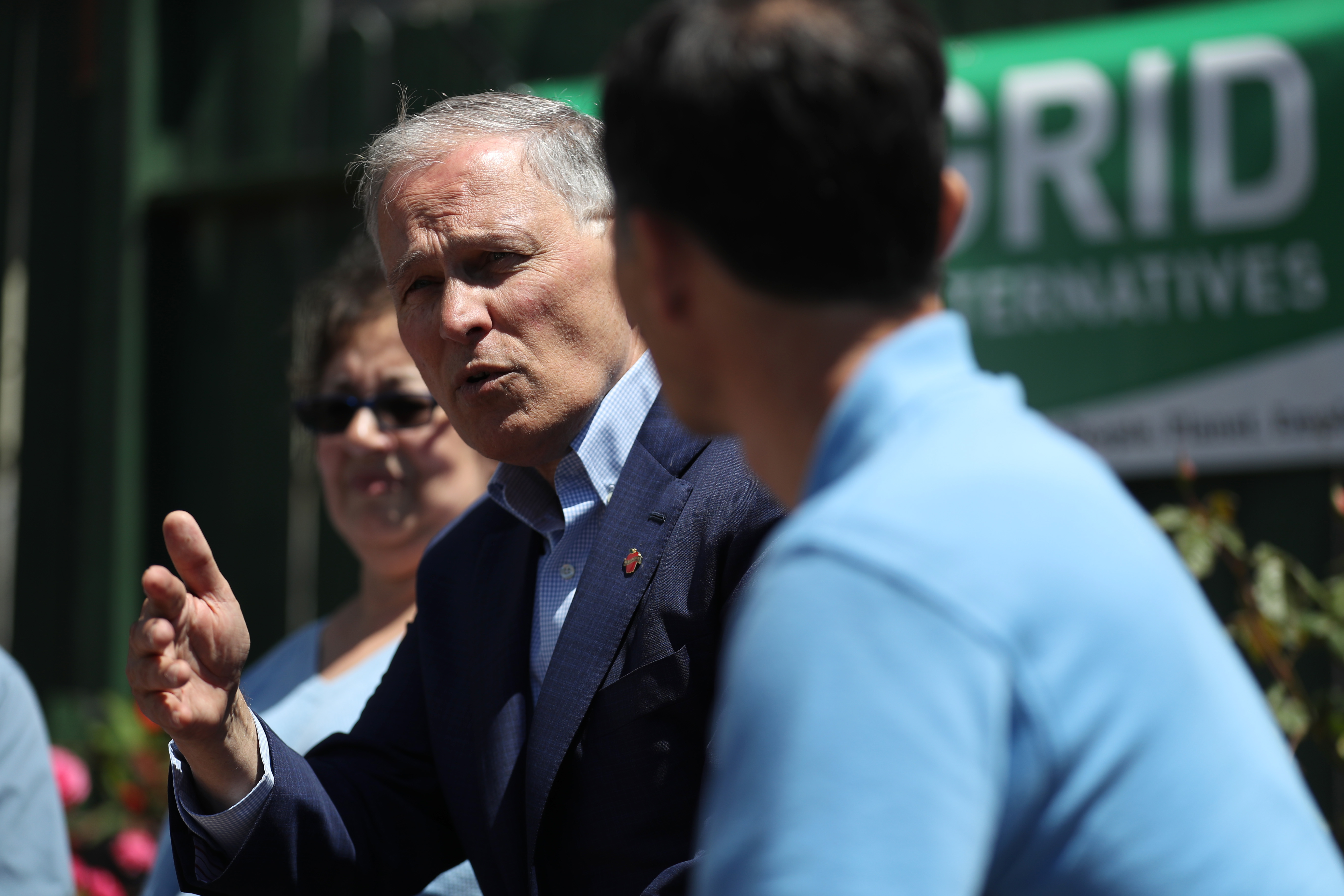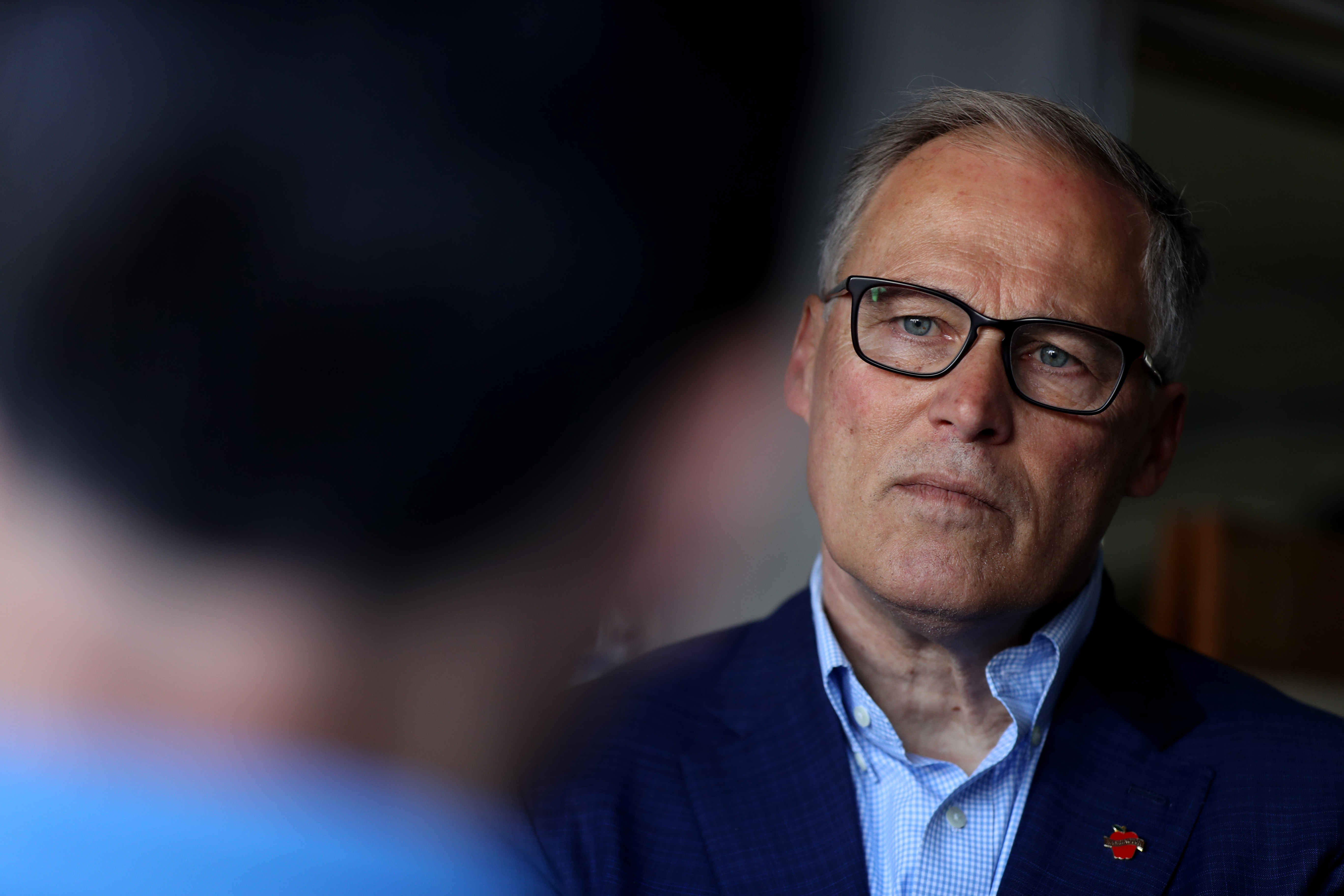
(Photo: Justin Sullivan/Getty Images)
Last month, Washington State Governor Jay Inslee, who’s billing himself as the climate candidate for the 2020 presidential election, released the most comprehensive climate action plan of any candidate in the field. Inslee’s Evergreen Economy plan proposes funneling $9 trillion over a decade to transition to clean energy, build out public transport and high-speed rail, invest in research into new agriculture and energy technology, and create a “G.I. Bill” for fossil fuel workers. Vox and Grist have likened Inslee’s plan to the Green New Deal, and GND pioneer Representative Alexandria Ocasio-Cortez herself has praised it on Twitter.
Polling at less than 1 percent within a crowded Democratic field, Inslee isn’t exactly a frontrunner for 2020. But his presence in the race, some commentators argue, will push other candidates to pay more attention to the climate crisis than they would otherwise. On Earth Day this year, Inslee asked his fellow 2020 candidates to join in him lobbying the Democratic National Committee to host a climate-centric debate (to which the DNC replied that it was still “ironing out the details” of the debates—something one might say about weekend plans to bat away a pestering acquaintance). At the very least, he’s trying.
As the governor of Washington, which recently passed a clean energy bill as well as a host of other environmental legislation, Inslee has scored tangible victories that demonstrate his competency in climate leadership. In a January profile in The Atlantic, Inslee points to solar farms in smaller Washington towns and his plan to expand electric ferries as two ways that he’s centered climate in his policymaking as governor.
But Inslee hasn’t always been an ideal legislator on environmental issues in his state, climate activists say. Seattleite Andrea Rodgers, a senior attorney at climate advocacy group Our Children’s Trust, says via email that Inslee’s “record [on climate] in Washington has been disappointing.” Rodgers points to a report recently published by the state’s ecology department reporting that emissions rose just over 6 percent from 2012 to 2015, during the first few years of Inslee’s governorship. Further, from 2015 to 2016, carbon dioxide emissions in the state increased by 7.5 percent, Rodgers says, drawing on data from the United States Energy Information Administration.
That rise in emissions isn’t entirely for lack of trying on Inslee’s part. Over the past few years, Inslee has backed several different carbon-pricing bills and initiatives in the state that have all fallen flat, partly thanks to the state’s split legislature. It was only with a Democratic majority that this month’s clean energy bill passed, which, notably, is focused more on utility reform, with no carbon tax. Inslee has stepped away from carbon pricing recently, partly (he says) because he’s come to believe that it distracts from other priorities, according to NBC.

(Photo: Justin Sullivan/Getty Images)
On other environmental issues, Inslee’s beliefs can sometimes seem to be ever-shifting—especially recently. Up until last month, Inslee was supportive of two proposed fossil fuel plants in Washington: a liquefied natural gas (LNG) facility in Tacoma, which was already under construction, and a methanol refinery. Both plants, which would increase production and use of natural gas, were controversial. The LNG facility, in particular, drew protests, not only for its anticipated emissions, but also because it would be built on ancestral Puyallup land. Then, in early May, Inslee changed his mind and came out against both facilities. Though some environmental groups like the Sierra Club applauded his reversal, others have been skeptical.
“There’s a lot of cheap talk in the state about climate action,” says Jamie Margolin, also a Seattleite and founder of youth-led climate activist organization Zero Hour, referring to Inslee’s record as governor. She adds that his dedication to tribal and climate-justice issues has been mixed. Climate activists and the local Puyallup tribe members have protested the Tacoma facility for years, beginning as early as 2015. The tribe said it was unlawful to build the project on their land, and activists warned that the project posed an environmental-justice hazard for the neighboring community, where it threatened to pollute the air and water. Four years of protesting paid off when Inslee withdrew his support for the facility, a decision that the tribal council chairman praised.
Margolin herself participated in some of these protests against the LNG facility and recalls that she was disappointed not to see Inslee to “walk the walk” on climate. She says his delay in rejecting new fossil fuel infrastructure in Washington gives her pause. “Where’s the [sense of] urgency?” Margolin asks. “Where’s the action?”
350 Seattle co-founder Michael Foster shares Margolin’s frustrations with Inslee. “I think he understands climate as well as anybody in office,” Foster says. “And yet, maybe because he learned about it in the ’90s … his understanding has not kept pace with the growing intensity” of the climate crisis. As an example of this gap in Inslee’s understanding, Foster points to the governor’s repeated attempts to pass a carbon tax, which Foster and many other climate commentators view as an outdated, ineffective policy.
“It’s just moving the deck chairs around,” he quips.
On the other hand, Nick Abraham, communications director for the non-profit Washington Environmental Council, is more inclined to defend Inslee’s record on environmental justice, saying that the governor has been learning and growing along with the rest of mainstream environmentalists.
“The environmental community, period, was bad about equity issues for a very long time, and still, in a lot of cases, are not where they need to be,” Abraham says.
Inslee hasn’t been perfect on climate. It also seems he’s now learning from his old mistakes. His previous proposal for a carbon tax bill, from 2018, lacked important provisions for low-income people and for displaced fossil fuel workers. Inslee includes both of those things in the Evergreen Economy plan, via the “G.I. Bill” for fossil fuel workers and policies supporting fair wages and affordable housing.
Despite her skepticism of Inslee as the governor, Margolin is cautiously optimistic about him as a presidential candidate. “In the grand scheme of things, he’s a lot better than other candidates,” she says, comparing Inslee favorably to former Vice President Joe Biden, whom she calls a “climate denier” on account of his weak, middle-of-the-road approach to climate policy. Rodgers and Foster both also say that, despite Inslee’s checkered history, his presence in the presidential race is encouraging—mostly because he’s the only candidate placing climate front and center.
Inslee’s reversals on environmental issues in his own state may raise questions about his history; they also reveal his ability to learn and adjust. And those shifts have led him to release the most comprehensive climate plan of any candidate in the field. If Inslee’s purpose in running isn’t to win, but rather to push other candidates to be more ambitious on climate, his campaign is off to an excellent start.





